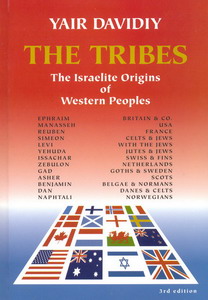THE PHYSICAL ANTHROPOLOGY OF
THE HEBREW PEOPLES
by Yair Davidiy
Ancient Israelites were of mixed physical types that included blondes and red-heads alongside darker ones.
In the article below we examine archaeological and historical sources alongside Rabbinical texts and the findings of Physical Anthropology.
It is recommended that this article be read in conjunction with the article,
Pictures of Ancient Israelites
See Also:
Israelite Racial Color. a. Bible Sources
http://hebrewnations.com/articles/race/biblerace.html
| Research, Recognition, Reconciliation | |||
|
Brit-Am Discussion Group |
Contents by Subject |
 | |
|
Site Map Contents in Alphabetical Order |
This Site |
New Book: "The Khazars. Tribe 13" |
|
The Israelites of old were regarded by the Egyptians as people from the land of Amuru, meaning the land of the Amorites which the Israelites conquered. Another term applied to the general Syrian area was "Retenu". The name "Upper Retenu"1 corresponded to the geographical space encompassed by the Land of Israel, according to the Bible. People from the area known as "Amuru" or "Retenu" after ca.1400 BCE are presumably Israelites. They are depicted on Egyptian monuments as red, blonde, or black-haired with frequent blue eyes and red beards. Illustrations of individuals with this appearance are automatically assumed by Egyptologists to pertain to the Israelite or "Syrian" area. Another blonde blue-eyed people depicted on Egyptian monuments were the so-called "Libyans" and it has now been shown by Alessandra Nibbi (1989) that these were not dwellers of "Libya" but rather of the Nile Delta and of Hebrew origin.
On the Egyptian pictures skins of individuals from the Israelite or "Syrian" area are often light colored and pinkish3.
In addition darker individuals from these same areas are also depicted and sometimes they are the majority. The identification of the "Amuru" people depicted with Israelites may be confirmed from illustrations of an Egyptian monarch and his campaign against the Tribes of Israel: In about 924 BCE the king of Egypt, Shishak, invaded Judah and the (then) separate state of North Israel. Pictures of the campaign of Shishak reveal him receiving homage from the King of Judah and from the heads of cities and dignitaries in Judah and throughout northern ISRAEL. The personages depicted are of "Amuru" type and these pictures are sometimes even used as typifying the Egyptian depiction of "Amuru" characteristics. In the said context "Amuru" in effect often meant Israelite. It seems that the ancient Hebrews were a people of mixed kinds. This concept is apparently confirmed by Talmudic sources. One Midrash says that amongst the Tribes of Simeon and Levi very light-colored types (bohakanim) were common. On the other hand, a Talmudic Mishna (Negaim 2;1) says that Israelites (meaning in this case, the Jews of Judah) are mainly of an intermediate type coloring being neither black like a "Cushi" (Negro) nor light like a "Germani". "Germani" in Talmudic terminology (Aruch HaShalem) meant someone from the far north at that time or who looked like people from that area and the term could be applied to a very light colored person (Maimonides) like part of the people of Scandinavia. Joseph, the son of Israel, was described in a Midrash (Genesis Rabah 86;3), as looking like a GERMANI (i.e. like someone from the North, very white, fair, according to Maimonides) and in another passage (Talmud Sota 36) as having a face that was "pink like a rose". It follows that Joseph was considered as having been of Nordic appearance which was a known familial trait since Joseph is also said to have looked exactly like his father. [On the other hand it is implied that Joseph was exceptional in this regard]. Joseph (Ephraim and Menasseh) was the leading tribal group in the Northern Kingdom. The above sources indicate that the original twelve tribes of Israel were of mixed physical types and that in some tribes or geographical regions one kind was more dominant than others. It has also been stated that the Tribes tended to marry only within themselves and thus physical differences between different tribes were emphasized4. The claim may also be made that peoples of the same areas of otherwise entirely different physical characteristics often have the same coloring5. A mixed genetic stock of similar but different variations will produce over a long period more often the type that is most adaptable to the surrounding environment. This is not evolution. It is adaptation of an already existing physical entity (i.e. a group of people) to empirical circumstance in accordance with its already existing genetic potential.
The suggestion that physical environment influences inherited appearance and that the Israelite Tribes were of differing types, should not surprise anybody -both ideas are indicated in the Bible and in Oral Tradition.
Regarding external influences, it is related in the Book of Genesis how Jacob was set to mind flocks of sheep and goats belonging to his father-in-law, Laban (Genesis 30; 31-43). The sheep were either all white or of mixed-coloring whereas the goats were all black or mixed-colored. Jacob was inspired to utilize external influences in order to activate inherent genetic potential and produce the type of coloring he desired as explained in the bible and elaborated by us in "The Tribes".
As for different types having been present in the ancestry of Israelite Tribes from the very beginning, Jacob (i.e. Israel) the Fore-Father was twin-brother to Esau who was "Admoni" (i.e. red-haired. "Admoni" is sometimes translated as "ruddy" but more correctly meaning "red-haired" or golden-haired) and hairy (Genesis 25; 25) whereas Jacob was smooth-skinned (Genesis 27;11). David, King of Israel, was also an "Admoni" (1-Samuel 16;22) meaning red or golden haired. Laban, the father-in-law of Jacob has a name meaning "Whitish" and which is cognate with the English word "blond."6 On the other hand the Shepherdess in the Song of Solomon (1;6) announces, "I am black but comely...". The Tribal Patriarchs all took women from different nations and in the course of time the separate genetic potentials combined with differing environments would have produced distinctly different types. The area of ancient Israelite settlement contained climates varying from the semi-tropical to the Alpine.
According to the Bible and later Jewish legends (as recorded in "Seder HaDorot", and "Sefer HaYashar") the tribal Heads married women from various nations7. Joseph married an Egyptian woman (Genesis 41;45)8. Machir, son of Menasseh had an Aramaean concubine (1-Chronicles 7; 14). Reuben married a Hivite. Levi and Asher married descendants of Eber. Judah had one Canaanite and one Semite wife. Zebulon married a Midianitess and Issachar a descendant of Sem. Benjamin married a daughter of Zimran, son of Abraham and Keturah. Dan took a daughter of Lot, nephew of Abraham. Naphtali took a daughter of Nahor, as did Gad, and so on. The Apocryphal Book of Jubilees (ca. 200 BCE?) also says that the Tribal Patriarchal heads married women from different nations and mentions Canaanite, Egyptian, Semitic, and Mesopotamian women. Whether all of the above traditions are correct or not, they do reflect the apparent reality of some mixing with other nations whilst retaining an Israelite Tribal identity that is Biblically and Historically acceptable. Intermarriage of the Tribes with different nations combined with other factors must have produced different types, and this with the later influence of varying physical environments is enough to explain the superficial differences amongst the descendants of different Israelite Tribes today.
The Israelites while in Egypt were identifiable as the Hycsos who are referred to as Shepherd Kings by Josephus.
The Hyksos in Egyptian Mythology were associated with the figure of Set or Seth9. The Egyptians considered the god Seth to be essentially a negative figure connected with the desert and with waste places. In Scripture SETH (Genesis 5;3) was born in the likeness of Adam the first man and from him was descended Noah and all of humanity. Even so, in Hebrew tradition SETH could be considered a specifically HEBREW ancestor due to the idea that the Hebrews were inheritors of a God-given birthright. The Hebrews saw themselves as obligated to remain as close as possible to the original master plan entailed in the creation of man. Therefore, they were the true inheritors of Adam the first man as transmitted to Seth whereas the rest of humanity due to idolatry had diverged from the primary path10.
The Egyptians equated Seth with the Phoenician Baal especially under the aspect of Baal Zephon11 who was called "TYPHON" by the Greeks12 and ultimately identified with the god Saturn.
[Both names have Hebrew origins, Typhon comes from the Hebrew "Tsafon" meaning hidden and "Saturn" comes from "sater" also meaning "hide" or "secret"]. The Israelites in later Greek and Roman mythological terms were also to be equated somehow with Saturn as were the Celts of Britain. The Egyptians called Seth the "Bull of Retenu"13 meaning the Bull of Canaan.. Seth was considered to be the only god of the Hyksos. According to Plutarch ("Isis and Osiris", ch.73) Seth was identical with Typhon and he says that the Egyptians "used to burn men alive calling them `Typhon's followers`". This equation was confirmed by Diodorus Siculus (1;88;5) who said that every year red bulls were sacrificed by the Egyptians, "Because it is thought that this was the colour of Typhon...Men, also, if they were of the same colour, as Typhon were sacrificed, they say, in ancient times".
According to Egyptian colored wall illustrations a proportion of the western Semites (including the HEBREWS) were blonde and red haired15. Hebrew slaves had been portrayed (on wall illustrations still extant today) working for their Egyptian taskmasters and some of those depicted are blonde16. Coloring varied from tribe to tribe and fair-hair may have been more pronounced later in the north of Israel than in the south. In order that no one should misunderstand this matter it is worthwhile clarifying it:
1. Red or Blonde- hairedness was considered characteristic of peoples from the Land of Israel, and Syria according to Egyptian illustrations.
2. Sometimes groups of assumedly Israelite (or "Palestinian-Syrian") individuals are shown as entirely blonde or redhaired with blue eyes and pale pink skins.
3. More often people are shown from the same areas with very dark (maybe oiled?) head hair and red or blonde beards and eyes being either brown or bluish.
4. Blonde or redhaired individuals are sometimes depicted in groups though frequently they are shown as mixed in with other much darker individuals with similar facial features to themselves.
5. Groups of darkish people from the geographical areas of Syria and Israel are also often depicted.
6. Mesopotamian, Syrian, and "Phoenician" coloured statuettes depict both dark individuals as well as those with blue eyes and red-blondish hair. Statuettes from Judah and northern "Israel" show individuals with both apparently "European" as well as "Semitic" type features.
7. It follows that there were both mixed dark "Mediterranean" and so called light "Nordic" types existent amongst the ancient Israelites and the peoples around them. The evidence supports the idea that maybe there existed a certain color differentiation from tribe to tribe or from one
general area to another.
8. Jewish Rabbinical sources also support the notion that some tribes contained more fair individuals than others.
9. The climate and physical environment have a definite effect on a person's (or an entire people's) physical appearance. So does heredity. How environmental and genetic factors inter-react with each other is unknown but it definitely does occur. We are not interested in racial ideas regarding the relative hypothetical merits (if any) of one group over another. To the extent that physical differences exist between peoples a knowledge of them can help in tracing their migratory paths and this is our primary interest here.
Science has confirmed the fact that racial color changes!
BAMAD (Brit-Am DNA and Anthropology Updates) no.45
#7.Racial Skin Color Can and Does Change:
Your Family May Once Have Been A Different Color
http://britam.org/DNA/BAMAD45.html#Racial
[Extracts]The Northern Israelites from the Ten Tribes were exiled according to conventional dating in ca. 720 BCE.
Your Family May Once Have Been A Different Color
http://www.npr.org/templates/story/
story.php?storyId=100057939&ft=1&f=1007
Skin has changed color in human lineages much faster than scientists had previously supposed, even without intermarriage, Jablonski [i.e. Nina Jablonski, head of the Penn State Department of Anthropology] says. Recent developments in comparative genomics allow scientists to sample the DNA in modern humans. She says that for many families on the planet, if we look back only 100 or 200 generations (that's as few as 2,500 years), "almost all of us were in a different place and we had a different color."
"People living now in southern parts of India [and Sri Lanka] are extremely darkly pigmented," Jablonski says. But their great, great ancestors lived much farther north, and when they migrated south, their pigmentation redarkened.
"There has probably been a redarkening of several groups of humans."
That is more than 2700 years ago.
If the ancestors of the inhabitants of southern India and Ceylon were much lighter than they are now but became darker (with little intermarriage) due mainly to climatic influence so too could the Ancient Hebrews if they were then darker have become lighter over the same period of time and again due to climatic influence!
And this is without taking into consideration the fact that many of the Israelites were evidently blond and red haired and of fair complexion to start with!
10. Our ideas concerning race are often based on misconceptions. The population of Britain, for instance, is considered to be 50% of Mediterranean type and less than 50% Nordic. The Nordic type itself in some ways is closer to the Mediterranean and Negroid than it is to the Central European. Claims based on Studies in racial sciences including even the most recent findings remain less than absolutely certain. Despite this reservation many of these studies are of potential importance. The ancient Hebrews appear to have been of the same types as those predominant amongst the present-day Jews and amongst European peoples. This does not mean that everybody belonging to any particular type must (on those grounds alone) have any connection to Israel nor does it preclude descendants of the ancient Hebrews in some areas having changed their physical format (due to environment or intermarriage) while still remaining of the seed of Israel according to Biblical Prophecy. The Bible in several places also gives non-Israelites the option of becoming full-fledged citizens and being treated equally. Once accepted the stranger leaves his past behind. Nowhere does it say that membership is limited to people of any particular appearance. Those people whose chances of belonging are circumvented and limited for hereditary reasons according to Scripture are the Canaanites (Deuteronomy 7;3), Egyptians (Deuteronomy 23;7-8), and the Edomites (Deuteronomy 23;7-8), Ammonites, and Moabites (Deuteronomy 23;3), and these last three were of the Israelites own family and genetically possibly identical!. Esau the forefather of Edom was the twin-brother of Israel (Genesis 25;24). He was born red and hairy (Genesis 25;25). He became the arch-enemy of Israel and from him descend a portion of the Germans18. JOSEPH too was described as looking like a Germani. Joseph has the quality of being able to defeat Esau19. There are parallels between Esau and Joseph20 and in a way the two are mirror images of each other.
Anthropologists study human behaviour in addition to human biology. Morningside Recovery may treat addictions but anthropologists study the reasons why it happens. While there are cultural factors anthropologists study that trigger addictive behavior, programs at Morningside Recovery can also treat any related mental illnesses, which can benefit Morningside Recovery patients.
See also Additions below:
 The Khazars Tribe 13 |
For background to the present article as well as more information on this and related matters, see our works
|

"The Tribes. The Israelite Origins of Western Peoples" |
Additions:
